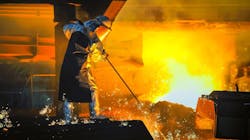Producing metalcastings demands a high degree of accuracy to ensure that finished products meet the required specifications. But consistently achieving precise, representative melt chemistry is challenging. Could real-time spectrometry data address this problem?
Traditional methods for evaluating melt chemistry are time-consuming, and still may be imprecise. However widespread they may be, modern sampling methods are hindered by the adverse (even hostile) operating environments that the metallurgical processes create. For instance, internet-connected devices cannot sense many variables because they risk damage in chemical processes.
Starting materials vary in composition, and molten metal samples are not always representative of the finished state, so predicting final chemistry can be challenging. These obstacles can complicate conventional quality-control processes.
Spectrometry is trusted and well-understood as a quality-control method. Spectrometers enable in situ analysis with minimal sample preparation. They can analyze the elemental composition of alloys down to trace levels, accelerating operating throughput. In fact, they can detect approximately 60 elements in a single minute.
What is real-time spectrometry
Industry professionals use optical emission spectrometry (OES) and laser-induced breakdown spectrometry (LIBS) as their primary spectroscopy techniques.
LIBS is installed in-process for elemental analysis. Since it is an emerging solution — likely due to the instrument’s high cost — it is not widely adopted yet. OES is a more common analytical solution for metallurgical applications.
This technique determines the elemental components in molten melts prior to casting by measuring the light that atoms and ions emit when de-excitation occurs. Its unparalleled sensitivity provides in-depth information. Because it works on a broad range of metals and alloys, it is the ideal technology for process and quality control in metalcasting.
Foundries use the instruments’ probes or lasers directly on the molten bath to collect spectral details. Specialized software converts that data into actionable chemical composition information within seconds, which is much faster than conventional methods.
Case study for melt chemistry
In-line analytical techniques can lower analysis time and cost by providing precise melt composition information in real time. For instance, LIBS devices can analyze impurities within molten metals with exceptional accuracy, but this technology is still in the early implementation stages. Engineers are exploring process improvements to increase adoption.
In 2024, one group developed a solution for a major immersion probe issue. A previous design used bubbling inside the melt, which inadvertently created spatial instabilities on the surface that the LIBS was analyzing. Slag formation and laser-jamming vapors further complicate the analysis and skew the output.
The engineers presented a novel mechanical stirring solution to mitigate this issue. Rotary blades ensure the surface is stable and renewed to guarantee the tool obtains accurate, representative spectroscopic measurements. It was purpose-built for molten metal monitoring at high temperatures, so its performance was excellent.
Tangible benefits of real-time optimization
Professionals can use spectrometry to monitor the composition of molten metal continuously while it is processed. It makes possible data-driven optimization to make the necessary adjustments in real time.
Compared with traditional lab sampling, this nondestructive testing method boasts reduced cycle times and increased accuracy. It shows if foundries are missing an essential ingredient or have too much of another, allowing for faster adjustments. Eliminating furnace idling time, reducing energy consumption, and shortening batch turnaround times can result in significant cost savings.
Real-time monitoring improves quality control, helping ensure the final metalcasting has precisely the properties it is meant to have. In addition to mitigating casting defects, it leads to superior mechanical properties.
When foundries rely on labor-intensive, imprecise conventional testing methods they risk producing out-of-spec batches that require extensive rework. Even modern electronics are inaccurate because they cannot withstand the hostile operating environment, leading to degradation.
Spectroscopy is more cost-effective because it reduces resource waste by precisely controlling melt chemistry. Metallurgists can avoid making castings that don’t meet the required specifications.
Implementation challenges to overcome
Over the past 30 years, numerous technological advancements have enabled spectroscopy techniques to become a mainstream solution for untargeted molecular and elemental imaging. Instruments like mass spectrometry imaging and OES have become well-established industry standards.
Yet, these solutions are not silver bullets. For one thing, the presence of various elements in the melt can interfere with the analysis of others. Matrix effects like spectral interferences can complicate real-time data interpretation, requiring sophisticated correction techniques.
Not all elements are easy to detect with a spectrometer. Some may have weak spectral lines or be too faint to measure accurately. Slag or other contaminants on the molten melt’s surface can interfere with readings. Technicians must ensure that their equipment is properly calibrated and well-maintained to provide accurate, representative sampling.
As engineers and researchers develop novel technological advancements, spectroscopy will evolve. Common implementation challenges may be overcome someday. Already, OES, mass spectrometry imaging and LIBS are transforming metallurgical processes.
About the Author
Ellie Gabel
Ellie Gabel is a freelance writer who specializes in covering innovations and advancements in science and technology. She's also an associate editor for Revolutionized.

